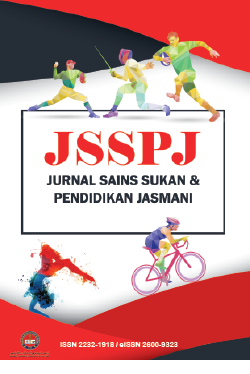Validity, Objectivity and Reliability of Volleyball Skills Instrument
DOI:
https://doi.org/10.37134/jsspj.vol11.1.9.2022Keywords:
Validity, Objectivity, Reliability, Volleyball Skills InstrumentAbstract
This study aimed to determine the validity, objectivity and reliability value of volleyball skills instruments. The study took place on a team from Serambi Mekkah University at Acheh. The sample of the study were 20 people aged 18 until 25 years old. Construct validity has been validated by three volleyball experts. The data analysis validity and objectivity used personal correlation, and the reliability data analysis used interclass and intraclass reliability coefficient. The results of the study indicated the validity value r = 93 was high. Next, the objectivity value for movement score of volleyball skills instrument among researcher’s score with tester assistance 1 was r = .949, with tester 2 was r = .864 and the correlation coefficient value between assistant tester one score with tester two was r = 880 which was high. Objectivity value of outcome score for volleyball skills instrument between the score of researcher with assistant tester one was r = .959, with tester two was r = .951 and next, correlation coefficient value between assistant tester one with tester two was r = 941 which was high. The reliability movement score for volleyball skills r= .841 was high. The reliability value outcome score for volleyball skills r =.920 was high. Thus, it was concluded that the volleyball skills instrument is fit to be a standard instrument to measure volleyball players’ skills aged 18 until 25 years old.
Downloads
References
Ahmad Hashim. (2015). Pengujian, Pengukuran dan Penilaian Pendidikan Jasmani. Edisi Pertama. Dubook Press Sdn Bhd.
Ahmad Hashim. (2014). Panduan Analisis Data Secara Efisien. Panduan Lengkap Berajah Untuk Menganalisis Data. Bangi: Dubook Press Sdn Bhd.
Ahmad Hashim. (2004). Pengukuran Kecergasan Motor. Tanjong Malim: Quantum Books
Arif, A. P., & Sujarwo, S. (2022). Instrument Validity and Reliability Confidence to Jump serve in Volleyball. Jurnal Olahraga, 7(1), 151-158.
Fraenkel, J. R., & Wallen, N. E. (1996). How to design and evaluate research in education (3rd ed.). New York: Mc Graw Hill Inc.
Hastad, D. N., & Lacy, A. C. (2002). Measurement and evaluation in physical educaton and exercise science(4th ed.). Massachusetts: Allyn & Bacon.
Garson, G.D. (2013). Validity & Reliability. USA: Statistical Publishing Associates.
Kumar, S. (2014). Differentials on passing ability between universal attackers and blockers of volleyball players. International Journal of Physical Education, Fitness and Sports, 3(4).
Morrow, J. R., Jackson, A. W., Disch, J. G., & Mood, D. P. (2005). Measurement And Evaluation In Human Performance (3rd ed.). Champaign, IL: Human Kinetics.
Medeiros, A. I. A., Marcelino, R., Mesquita, I. M., Palao, J. M., Medeiros, A. I. A., Marcelino, R., Palao, J. M. (2017). Performance differences between winning and losing under-19, under-21 and senior teams in men’ s beach volleyball. International Journal of Performance Analysis in Sport, 17(1–2), 96–108.
Miller, D. K. (1998). Measurement By The Physical Educator. Dubuque, Iowa: Wm. C. Brown.
Niaz, M (2018). Evolving nature of objectivity in the history of science and its implications for science education. New York. Kenneth Tobin, City University
Safrit, M. J., & Wood, T. M. (1995). Introduction To Measurement In Physical Education and Exercise Science. 3rd ed. St. Louis: Times Mirror/Mosby
Serrano, A. G. de A., David Valades, & Palao, J. M. (2016). Evolution of game’s demands from young to elite players in men’s volleyball, International Journal of Sports Physiology and Performance, Human Kinetics, Inc.
Sidek Mohd Noah & Jamaludin Ahmad. (2005). Pembinaan Modul. Bagaimana Membina Modul Latihan dan Modul Akademik. Selangor: Penerbit Universiti Pertanian Malaysia.
Tuckman, B. W., & Waheed, M. A. (1981). Evaluation an individualized science programme for community collage students. Journal of Research in Science Teaching, 18, 489-495.
Valette, R. M. (1977). Modern language testing: A handbook (2nd ed.). New York: Harcourt Brace Jovanovich.
Yudasmara, D. S., & Fadhli, F. (2018). Development of Volleyball Course Scoring Instrument for Students. In Proceedings of the 2nd International Conference on Sports Science, Health and Physical Education. Volume 1, pages 153-157
Zonifa, G. (2020). A volleyball skills test instrument for advanced-level students. Journal of Physical Education & Sport, 20.
Downloads
Published
Issue
Section
License
Copyright (c) 2022 Febi Aulia, Ahmad Hashim, Zulakbal Abd Karim, Saifuddin, Sadzali Hassan

This work is licensed under a Creative Commons Attribution-NonCommercial-ShareAlike 4.0 International License.





